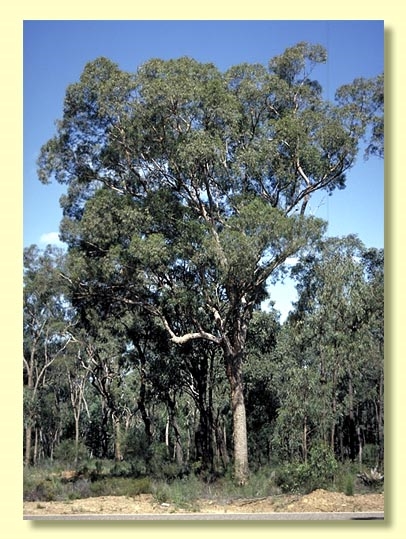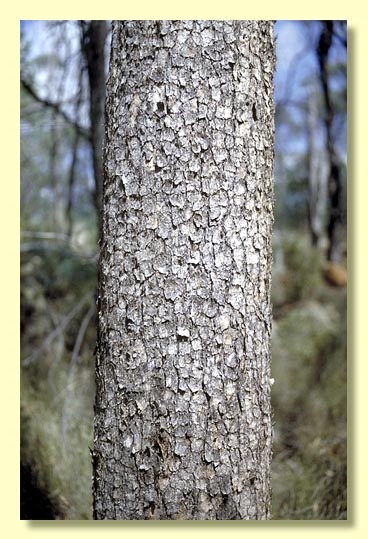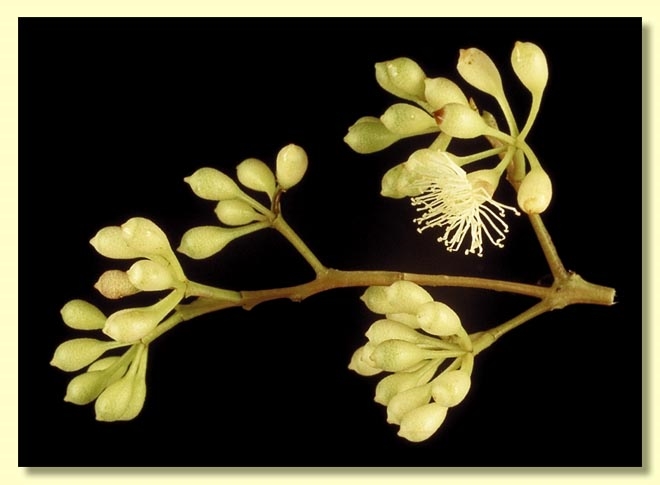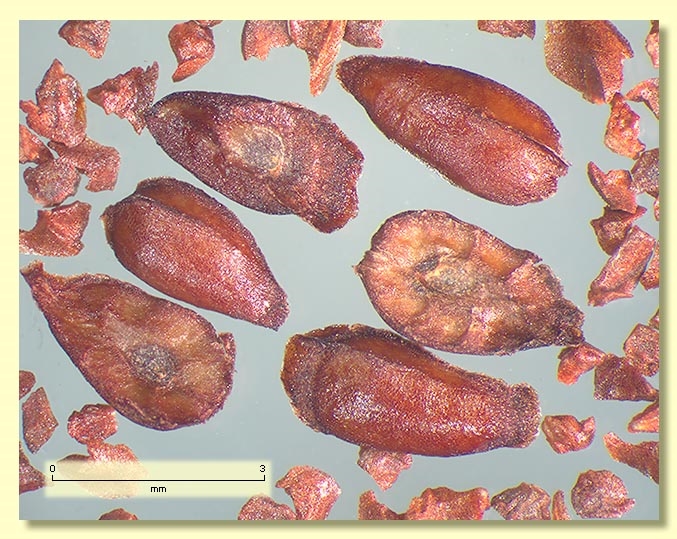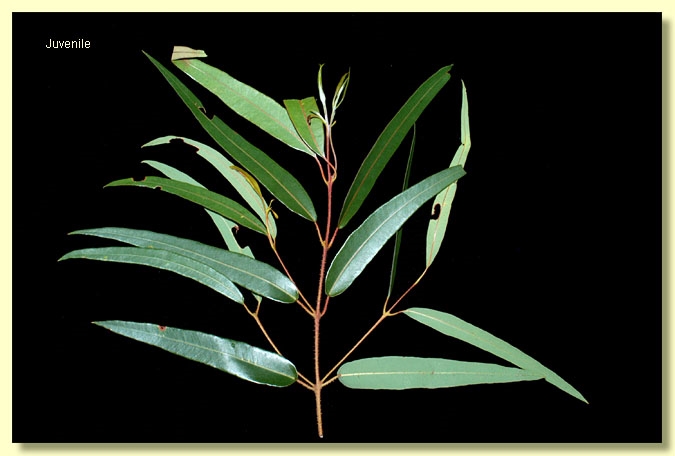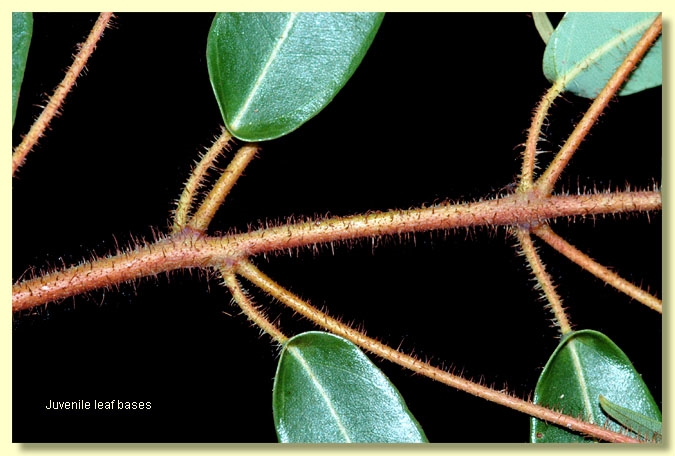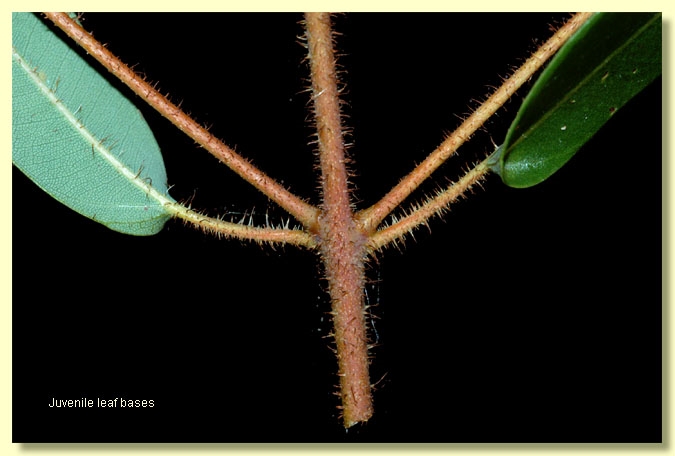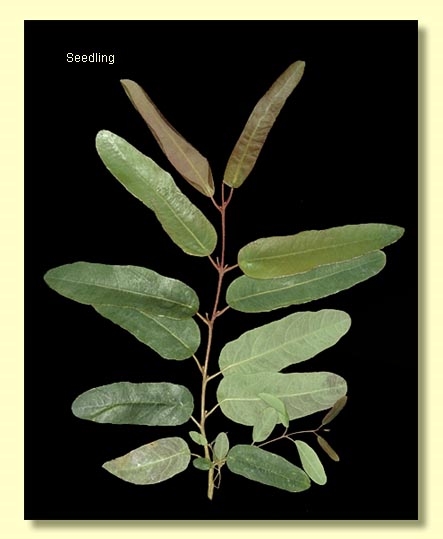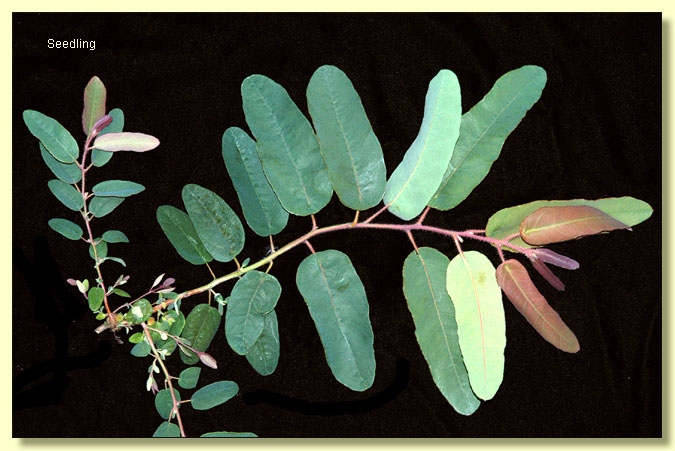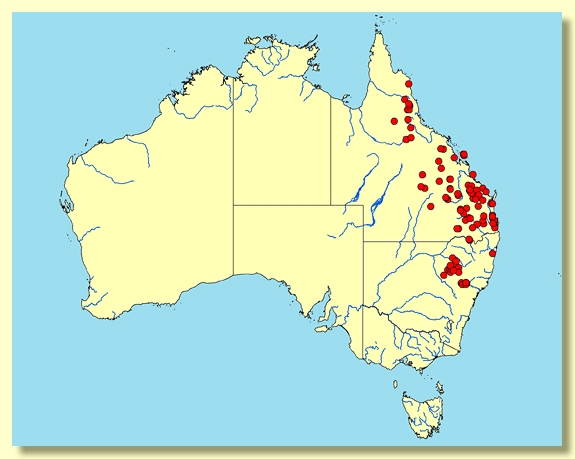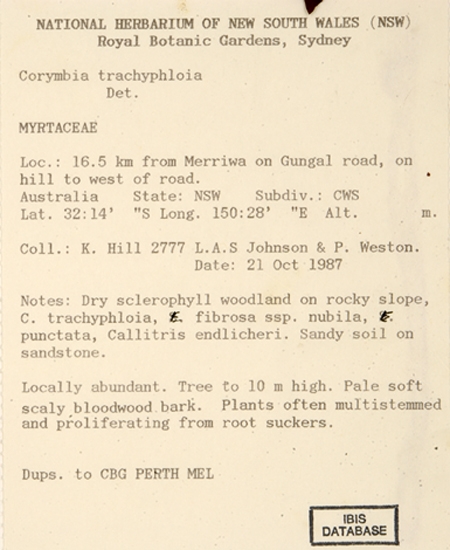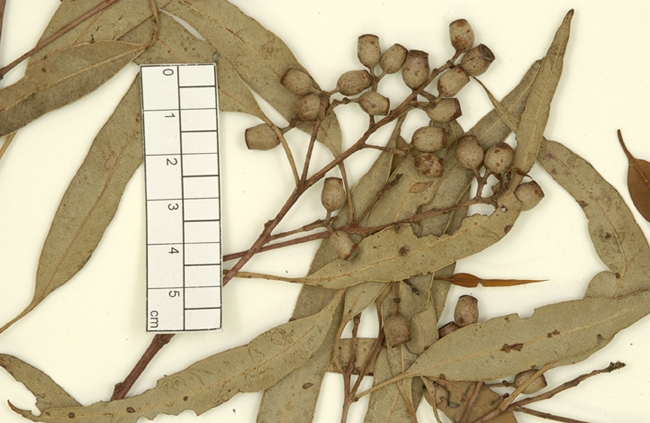Euclid - Online edition
Corymbia trachyphloia
Corymbia | Apteria
Bark rough on trunk often extending to branches about 6 cm diameter, tessellated, soft, grey, brown and yellow-grey.
Juvenile growth (coppice or field seedlings to 50 cm): stem rounded in cross-section, setose at first; juvenile leaves always petiolate, opposite for 2 to 4 nodes then sub-opposite, becoming alternate, lanceolate, 5–12 cm long, 1–3.5 cm wide, base rounded, peltate, discolorous, glossy, green; stems, petioles, and underside of lamina setose for many pairs.
Adult leaves alternate, petiole 0.8–2 cm long; blade narrowly lanceolate to lanceolate, 6.5–14 cm long, 0.9–2.6(4) cm wide, base tapering to petiole, usually discolorous, usually glossy and dark green above, strongly penniveined, very densely reticulate, intramarginal vein parallel to and just within margin, oil glands sparse and island, or obscure.
Inflorescence terminal compound, peduncles 0.4–1.3 cm long, buds 7 per umbel, pedicel 0.2–0.7 cm long. Mature buds pyriform, 0.4–0.5 cm long, 0.2–0.4 cm wide, yellow or creamy, smooth, scar absent (both opercula shed together at flowering), operculum rounded and sometimes apiculate, stamens inflexed, anthers oblong, versatile, dorsifixed, dehiscing by longitudinal slits (non-confluent), style long, stigma slightly mop-like, locules 3 or 4, the placentae each with 3–5 vertical ovule rows. Flowers white.
Fruit pedicellate (pedicels 0.2–0.7 cm long), urceolate, 0.6–1 cm long, 0.5–0.8 cm wide, walls thin, disc descending, valves 3 or 4, enclosed.
Seeds brown to yellow to reddish brown, 2–5 mm long, flattened-ellipsoidal with a median dorsal keel, with a very short blunt flange at one end (unwinged), dorsal surface smooth, hilum ventral.
Cultivated seedlings (measured at ca node 10): cotyledons reniform to orbicular; stems rounded in cross-section, setose for 12+ nodes or becoming smooth (glabrous) after some 8–10 nodes; leaves always petiolate (to 1.5 cm), opposite for 2 or 3 nodes then subopposite becoming alternate by ca node 7, oblong to lanceolate, 6–16 cm long, 1.5–4 cm wide, base rounded to ca node 4 then peltate, margin entire or irregularly indented, apex pointed or rounded, discolorous, dull, green, setose for ca 12+ pairs at least on underside. The setae are adorned with simple hairs.
Flowering has beeen recorded in January, February, March, April, May, June, August and December.
A small to medium-sized forest tree or sometimes a mallee, widespread north from the Goulburn River area in central-eastern New South Wales, extending through coastal and inland areas of Queensland to the Carnarvon Range, Blackdown Tableland north to the Atherton Tableland, and also South Percy Island, usually on poor sandstone or granitic soils. Corymbia trachyphloia has loose, flaky tessellated brownish grey to yellow-grey bark over the trunk and larger branches but with smooth outer branches. Crown leaves are darker green above and paler below with an obvious intramarginal vein. Buds are smooth and lack an operculum scar, whilst the fruit are thin-rimmed, ± urn-shaped and < 1 cm long. The wingless, keeled, red-brown, shiny, flattish seed resemble those of the yellow bloodwood species and the spotted gums.
Throughout its extensive natural range C. trachyphloia is readily distinguishable from other bloodwood species, especially if its non-scurfy buds, small fruit (to 0.8 cm diam.) and wingless seeds are available for inspection. It is most likely to be superficially confused with C. clarksoniana and C. intermedia, both of which have fruit at least 1 cm diameter, seeds with a pronounced terminal wing and much tighter, not flaky/spongy, rough bark. Two other bloodwoods from central Queensland, C. brachycarpa and C. clandestina, also have smallish fruit approaching the upper dimensions of those of C. trachyphloia but again have winged seed and tighter tessellated bark.
The rough bark of C. trachyphloia resembles that of the yellow-bloodwoods, e.g. C. leichhardtii and C. eximia, in texture and sometimes also in colour but is usually browner, and the seed morphology is also similar to species in this group. C. trachyphloia is always distinguishable from all yellow-bloodwood species because it retains its outer (sepaline) operculum until flowering, unlike the yellow bloodwoods, which shed this structure early in bud development, leaving the operculum scar easily visible. The fruit of all yellow bloodwood species are thicker walled and thicker rimmed than in C. trachyphloia.
Hill & Johnson (1995) divided C. trachyphloia into three subspecies largely on the presence or absence of stomata on the upper leaf surface and on the width of the intermediate leaves. C. trachyphloia subsp. trachyphloia has hypostomatic leaves (stomata only on the underside). C. trachyphloia subsp. amphistomatica has stomata on both leaf surfaces, and C. trachyphloia subsp. carnarvonica is similarly amphistomatic but has intermediate leaves wider than those of the other two subspecies (though the range of widths overlaps). In EUCLID these subspecies are not recognised as being distinct.
MORE ABOUT CORYMBIA
UNGROUPED SPECIES IN CORYMBIA

